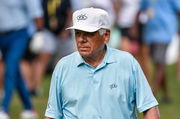
Imago
Image Courtesy: IMAGO

Imago
Image Courtesy: IMAGO
The 2025 U.S. Open at Oakmont is living up to its punishing reputation, and then some. Through two rounds, only a handful of players remain under par, with JJ Spaun clinging to a narrow lead at -4. The course’s brutal setup has turned every shot into a battle, and the leaderboard into a survival chart. Thick roughs, lightning-fast greens, and brutally long rounds have dominated the narrative, with even the world’s best struggling to string together red numbers.
Watch What’s Trending Now!
But amid the scores and storylines, a different kind of controversy is heating up: the pace of play. Scottie Scheffler and Viktor Hovland, two of the game’s biggest names, are drawing attention not for their scores—Scheffler at +7 and Hovland hovering near the cut line—but for how long it’s taking them to post those numbers. Their group, which is together in Round 2, has become a focal point of frustration on Friday morning after an eyebrow-raising statistic goes viral.
8.07am: Scheffler’s group finishes 11th hole
8.51am: Scheffler’s group finishes 12th holeThey’ve played 3 holes. In 71 mins. pic.twitter.com/9NrQYX3QYa
— Jamie Kennedy (@jamierkennedy) June 13, 2025
ADVERTISEMENT
“They’ve played 3 holes. In 71 minutes.” That’s the post from golf analyst Jamie Kennedy on X, timestamping the group’s pace from hole 11 to 12. It wasn’t long before fans piled on. That stat lit a fuse online, and soon the conversation turned into a debate over who—or what—was really to blame.
Top Stories
Lee Trevino, 86, Leaves Golf World Hanging on Every Word at PNC: ‘I’ve Been Digging Worms’

Paige Spiranac Shares Her Mom’s Honest Views on Controversial Career Decisions

LIV Golf Issues Statement as Pro Announces Shock Retirement After Getting Relegated

‘Losers’: PGA Tour Pro Blasts Fan Behavior After Viral NFL Arena Incident

Korean PGA Tour Star Clears the Air on LIV Golf Rumors With Blunt Message

Scheffler and Hovland face backlash over snail-paced play
One commenter quickly pointed out a nuance: “They were waiting on the 12th tee for like 10–15 mins. Huge backup on that hole.” Fair. Oakmont’s layout, combined with thick five-inch rough and strategic tee placements, is causing visible pileups. The par-5 12th in particular has been a bottleneck.
ADVERTISEMENT
Still, others were less forgiving. “Penalize them!!!!” another user shouted into the digital void, expressing the growing fatigue among fans tired of five-and-a-half-hour rounds. That frustration is shared across the fanbase and players. As one fan reminded, “Yeah, Michael Kim said yesterday it took just over 3 hours to play the front 9. That’s insane.” He’s right. Kim, a PGA pro, noted the absurdity of slow play creeping deeper into elite events. And while Kim didn’t mention Scheffler or Hovland specifically, the broader point stands: rounds are dragging on, and players’ rhythm, not just the scoreboard, is taking a hit.
Another user nailed that idea: “Sad there is such slow play. It throws you off your rhythm.” For players trying to grind through Oakmont’s mental and physical stress test, delays can be as damaging as missed putts. Waiting on every shot, losing momentum—at a place like Oakmont, that’s a recipe for implosion. Some, though, took aim higher up the chain. “Dumpster fire tournament all around,” one user wrote. “Ridiculous setup,” said another. And perhaps most telling: “That’s on the USGA.” These aren’t isolated gripes. The USGA’s 2025 course setup—widely criticized for dense rough and punitive pin placements—has played a huge role in slowing down play. Fairways are narrow, greens are rolled to 14 on the Stimpmeter, and the rough (a blend of Kentucky bluegrass, ryegrass, and Poa annua) is so thick that simply finding your ball is a task, let alone escaping it.
ADVERTISEMENT
Scheffler and Hovland, neither of whom has a history of slow play, seem to have been caught in the system’s slow-motion web. But as the U.S. Open barrels toward the weekend, patience is wearing thin for players and fans alike.
ADVERTISEMENT
ADVERTISEMENT
ADVERTISEMENT

